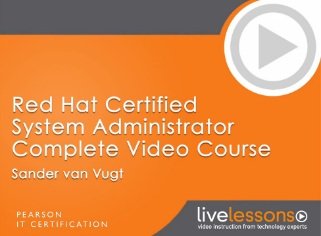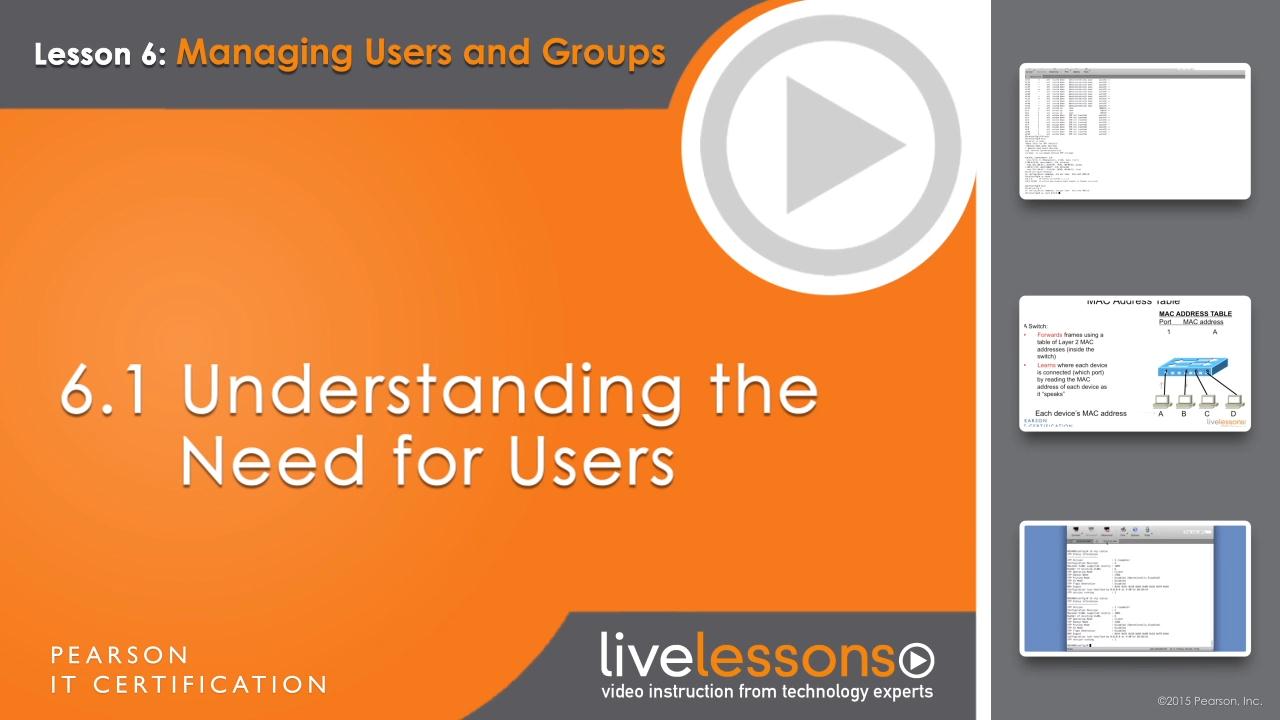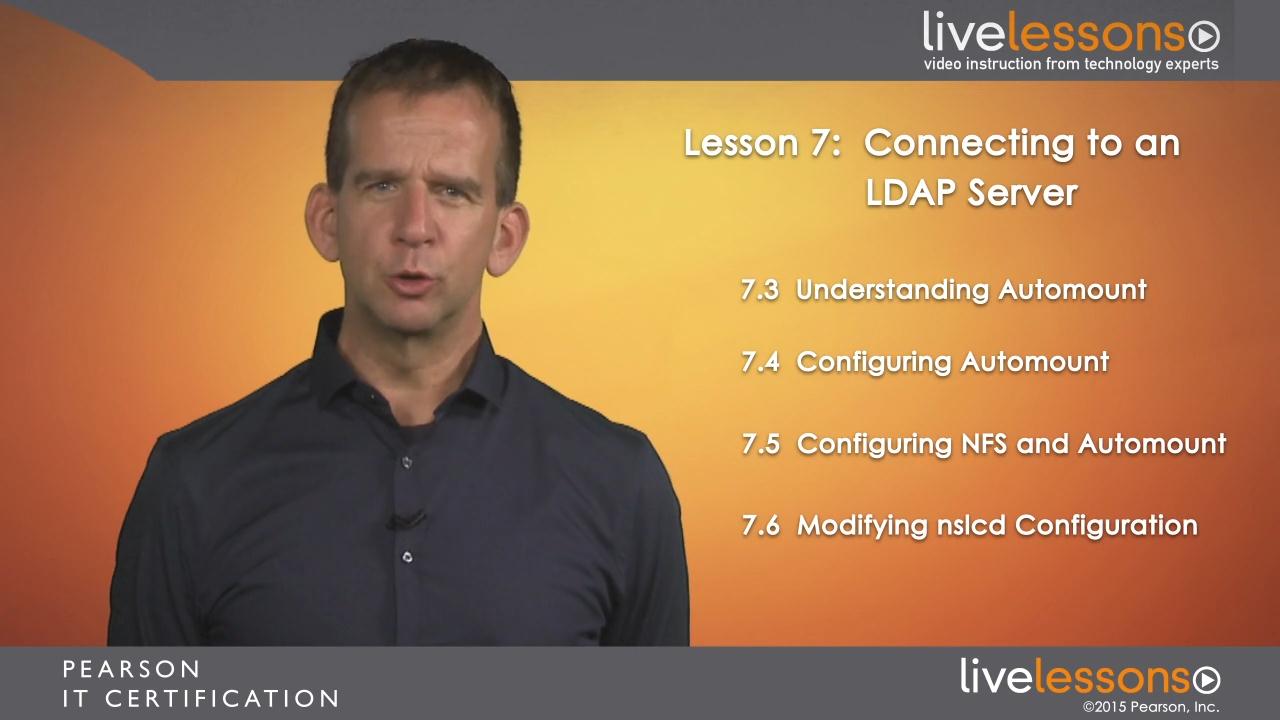
Red Hat Certified System Administrator (RHCSA) Complete Video Course: Red Hat Enterprise Linux 7
Red Hat Certified System Administrator (RHCSA) Complete Video Course is an engaging self-paced video training solution that provides learners with more than 16 hours of personal visual instruction from an RHCSA and RHCE certified expert with more than 20 years of practical Linux teaching experience. Through the use of topic-focused instructional videos you will gain an in-depth understanding of the Red Hat Certified Administrator (RHCSA) exam as well as a deeper understanding of Red Hat Enterprise Linux so you master the key foundational principles of systems administration. Included with the product are dynamic and interactive hands-on exercises and quizzes designed to test your knowledge while you study. The course includes 100% coverage of exam objectives, hands-on exercises included with each lesson so you can practice what you learned in a real CLI environment, multiple-choice quizzes to help you test your knowledge, and hands-on exercises to give you the extra edge you need to excel on the exam.
Description
Red Hat Certified System Administrator (RHCSA) Complete Video Course contains more than 12 hours of training with content divided into 4 modules with 26 video lessons. The videos consist of live trainer discussions, CLI presentations, live demos, and practice exam exercise walk-throughs. The video lessons in this course review each exam objective so you can use this course as a complete study tool for taking the Red Hat Certified System Administrator (RHCSA) Complete Video Course. Instruction throughout offers detailed explanations, demos, tips, and more.
This Complete Video Course includes interactive hands-on exercises for each lesson with thorough video explanations. The streaming site also includes module quizzes and exercises so you can test your knowledge every step of the way.
Major topics include
Module 1: Performing Basic System Management Tasks
1: Installing Red Hat Enterprise Linux Server
2: Using Essential Tools
3: Essential File Management Tools
4: Working with Text Files
5: Connecting to a RHEL Server
6: Managing Users and Groups
7: Connecting to an LDAP Server
8: Managing Permissions
9: Configuring Networking

Module 2: Operating Red Hat Enterprise Linux Servers
10: Managing Processes
11: Managing Software
12: Working with Virtual Machines
13: Scheduling Tasks
14: Configuring Logging
15: Managing Partitions
16: Managing LVM Logical Volumes
Module 3: Performing Advanced System Administration Tasks
17: Managing the Kernel
18: Using Kickstart
19: Managing and Understanding the Boot Procedure
20: Applying Essential Troubleshooting Skills
Module 4: Managing Network Services:
21: Managing HTTP Services
22: Managing SELinux
23: Configuring a Firewall
24: Configuring FTP Services
25: Configuring Time Services
26: Configuring VNC Access
Skill Level
* Beginning to intermediate
What You Will Learn
– Key concepts for all the objectives on the Red Hat Certified Administrator (RHCSA) exam
– Information on the new RHEL 7 exam
Who Should Take This Course
Primary audience:
Red Hat Certified Administrator (RHCSA) certification candidates
Secondary audience:
– Anyone interested in learning about Red Hat from the ground up
– Linux engineers who are interested in learning more about Red Hat Enterprise Linux
– Junior system administrators who want to deepen their skills
– Administrators currently administering UNIX systems and developers who write software for Linux
Course Requirements
The ideal target student has some preliminary Linux knowledge already, because this course focuses on Linux administration rather than on basic Linux usage.
Table of Contents
I Introduction
II What to Expect on the RHCSA Exam
III Preparing an Environment for Doing Exercises
Module 1 Performing Basic System Management Tasks
1 Installing Red Hat Enterprise Linux Server
Learning Objectives
1.1 What You Need on Your Server
1.2 Installing Red Hat Enterprise Linux Server
Exercise 1
Summary
2 Using Essential Tools
Learning Objectives
2.1 Using man
2.2 Understanding vim
2.3 Editing Text Files with vim
2.4 Understanding Globbing and Wildcards
2.5 Using Globbing and Wildcards
2.6 Understanding I/O Redirection and Pipes
2.7 Using I/O Redirection and Pipes
Exercise 2
Explanation to Exercise 2
Summary
3 Essential File Management Tools
Learning Objectives
3.1 Understanding Linux File System Layout
3.2 Essential File Management Tasks
3.3 Finding Files 3.4 Understanding Links
3.5 Working with Links
3.6 Working with tar
Exercise 3
Explanation to Exercise 3
Summary
4 Working with Text Files
Learning Objectives
4.1 Understanding Regular Expressions
4.2 Using Common Text Tools (tail, head, tr, cut, sort)
4.3 Working with grep
4.4 sed and awk Basics
Explanation to Exercise 4
Summary
Lesson 4 Interactive Exercise
5 Connecting to a RHEL Server
Learning Objectives
5.1 Opening Local Shells (Including Virtual Consoles)
5.2 Connecting to a Server with SSH
5.3 Understanding SSH Keys
5.4 Using SSH Keys
Exercise 5
Explanation to Exercise 5
Summary
Lesson 5 Interactive Exercise
6 Managing Users and Groups
Learning Objectives
6.1 Understanding the Need for Users
6.2 Understanding User Properties
6.3 Creating and Managing Users
6.4 Understanding Group Membership
6.5 Creating and Managing Groups
6.6 User and Group Configuration Files
6.7 Managing Password Properties
Exercise 6
Explanation to Exercise 6
Summary
7 Connecting to an LDAP Server
Learning Objectives
7.1 Understanding LDAP
7.2 Telling Your Server Where to Find the LDAP Server
7.3 Understanding Automount
7.4 Understanding sssd
7.5 Modifying sssd Configuration
Exercise
Explanation to Exercise 7
Summary
8 Managing Permissions
Learning Objectives
8.1 Understanding Ownership: Users, Groups,, and Others
8.2 Changing File Ownership
8.3 Understanding Basic Permissions
8.4 Managing Basic Permissions
8.5 Understanding Special Permissions
8.6 Managing Special Permissions
8.7 Understanding ACLs
8.8 Managing ACLs
Exercise 8
Explanation to Exercise 8
Summary
Lesson 8 Interactive Exercise
9 Configuring Networking
Learning Objectives
9.1 Understanding NIC Naming
9.2 Managing NIC Configuration with the ip Command
9.3 Storing Network Configuration Persistently
9.4 Understanding Network Manager
9.5 Using Network Manager Utilities (nmcli, nm-tool)
9.6 Understanding Routing and DNS
9.7 Configuring Routing and DNS
9.8 Understanding Network Analysis Tools
9.9 Using Network Analysis Tools
Exercise 9
Explanation to Exercise 9
Summary
Module 1 Quiz
Module 2 Operating Red Hat Enterprise Linux Servers
10 Managing Processes
Learning Objectives
10.1 Understanding Jobs and Processes
10.2 Managing Shell Jobs
10.3 Getting Process Information with ps
10.4 Understanding Memory Usage
10.5 Understanding Performance Load
10.6 Monitoring System Activity with top
10.7 Sending Signals to Processes
10.8 Understanding Priorities and Niceness
10.9 Changing Process Nice Values
Exercise 10
Explanation to Exercise 10
Summary
Lesson 10 Interactive Exercise
11 Managing Software
Learning Objectives
11.1 Understanding Meta Package Handlers
11.2 Setting Up Yum Repositories
11.4 Using rpm Queries
Exercise 11
Explanation to Exercise 11

Summary
Lesson 11 Interactive Exercise
12 Working with Virtual Machines
Learning Objectives
12.1 Introducing KVM Virtualization
12.2 Managing Libvirt and KVM
12.3 Using virsh
12.4 Using virt-manager
Exercise 12
Explanation to Exercise 12
Summary
13 Scheduling Tasks
Learning Objectives
13.1 Cron Versus at
13.2 Understanding Cron Configuration Files and Execution Times
13.3 Scheduling with Cron
13.4 Using at
Exercise 13
Explanation to Exercise 13
Summary
14 Configuring Logging
Learning Objectives
14.1 Understanding Rsyslogd and Journald Logging
14.2 Integrating Rsyslogd and Journald
14.3 Configuring Rsyslog Logging
14.4 Working with Journald
14.6 Configuring logrotate
Exercise 14
Explanation to Exercise 14
Summary
Lesson 14 Interactive Exercise
15 Managing Partitions
Learning Objectives
15.1 Understanding Disk Layout
15.2 Creating Partitions
15.3 Understanding File System Differences
15.4 Making the File System
15.5 Mounting the Partition Manually
15.6 Understanding /etc/fstab
15.7 Mounting Partitions via /etc/fstab
15.8 Understanding Encrypted Partitions
15.9 Creating a LUKS Encrypted Partition
15.10 Dealing with “Enter root password for maintenance mode”
Exercise 15
Explanation to Exercise 15
Summary
Lesson 15 Interactive Exercise
16 Managing LVM Logical Volumes
Learning Objectives
16.1 Why use LVM
16.2 Understanding LVM Setup
16.3 Creating an LVM Logical Volume
16.4 Understanding Device Mapper and LVM Device Names
16.5 Understanding LVM Resize Operations
16.6 Growing an LVM Logical Volume
16.7 Shrinking an LVM Logical Volume
Exercise 16
Explanation to Exercise 16
Summary
Lesson 16 Interactive Exercise
Module 2 Quiz
Module 3 Performing Advanced System Administration Tasks
17 Managing the Kernel
Learning Objectives
17.1 Understanding the Modular Structure of the Kernel
17.2 Working with Kernel Modules
17.3 Modifying Kernel Module Behavior Through modprobe
17.4 Tuning Kernel Behavior Through /proc
17.5 Using sysctl
17.6 Updating the Kernel
Exercise 17
Explanation to Exercise 17
Summary
Lesson 17 Interactive Exercise
18 Using Kickstart
Learning Objectives
18.1 Understanding Kickstart Usage
18.2 Creating a Kickstart File
18.3 Using the Kickstart File for Automatic Installations
18.4 Using Kickstart Files in Fully Automated Datacenters
Exercise 18
Explanation to Exercise 18
Summary
19 Managing and Understanding the Boot Procedure
Learning Objectives
19.1 Boot Procedure Generic Overview
19.2 Understanding Grub2
19.3 Modifying Grub2 Parameters
19.4 Understanding systemd
19.5 Managing Services in a systemd Environment
19.6 Understanding systemd Targets
19.7 Switching Between systemd Targets
19.8 Managing File System Mounts in a systemd Environment
19.9 Managing Automount in a systemd Environment
Exercise 19
Explanation to Exercise 19
Summary
20 Applying Essential Troubleshooting Skills
Learning Objectives
20.1 Changing Grub Parameters on Boot
20.2 Making Grub Changes Persistent
20.3 Starting the rescue.target Mode
20.4 Changing the Root Password
Exercise 20
Explanation to Exercise 20
Summary
Module 3 Quiz
Module 4 Managing Network Services
21 Managing HTTP Services
21.1 Understanding Apache Configuration
21.2 Creating a Basic Website
Exercise 21
Explanation to Exercise 21
Summary
22 Managing SELinux
Learning Objectives
22.1 Understanding the Need for SELinux
22.2 Understanding SELinux Modes and Policy
22.3 Understanding SELinux Labels and Booleans
22.4 Using File System Labels
22.5 Understanding semanage fcontext and chcon Differences
22.6 Using Booleans
22.7 Configuring SELinux for Apache
Exercise 22
Explanation to Exercise 22
Summary
Lesson 22 Interactive Exercise
23 Configuring a Firewall
Learning Objectives
23.1 Understanding Firewall Configuration
23.2 Using Firewalld
Exercise 23
Explanation to Exercise 23
Summary
24 Configuring FTP Services
Learning Objectives
24.1 Understanding FTP Configuration
24.2 Configuring an FTP Server for Anonymous Downloads
Exercise 24
Explanation to Exercise 24
Summary
25 Configuring Time Services
Learning Objectives
25.1 Understanding Time on Linux
25.2 Setting Up a Chrony Time Server
Exercise 25
Explanation to Exercise 25
Summary
26 Configuring VNC Access
Learning Objectives
26.1 Understanding VNC
26.2 Configuring a VNC Server
26.3 Connecting to a VNC Server
Exercise 26
Explanation to Exercise 26
Summary
Course Interactive Exercise
Module 4 Quiz
Course Intro
This session introduces the course and explains what students can expect of it.
What to expect on the RHCSA exam
This session explains what participants can expect on the RHCSA exam.
Preparing an Environment for Doing Exercises
This session explains how participants can set up an environment in which they can do hands-on practice.
Module 1: Performing Basic System Management Tasks
Lesson 1: Installing Red Hat Enterprise Linux Server
In this lesson, the participant learns how to install Red Hat Enterprise Linux Server. In this important lesson the student sets up the environment he can use for further practice during the rest of this course.
Lesson 2: Using Essential Tools
This lesson revises basic shell skills, such as editing text files, using commands, and finding help. It also discusses input/output redirection.
Lesson 3: Essential File Management Tools
This lesson revises how to use essential file management tools that enable administrators to list, copy, move, and delete files and to create hard and symbolic links. It also discusses how to compress and archive files and how to find files.
Lesson 4: Working with Text Files
In this lesson, the student learns how to process text files. Regular expressions as well as common tools such as grep, cut, and tail, are discussed.
Lesson 5: Connecting to a RHEL Server
This lesson teaches how to connect to a RHEL Server. It includes local connection methods such as virtual consoles, but also discusses how to connect to a server using SSH and VNC.
Lesson 6: Managing Users and Groups
In this lesson, the student learns how to create and manage user and group accounts. It also covers authentication against an LDAP Directory server.
Lesson 7: Connecting to an LDAP Server
In this lesson, students learn how to connect Red Hat Enterprise Server to an LDAP Server to handle authentication.
Lesson 8: Managing Permissions
This lesson teaches how to manage file permissions and Access Control Lists.
Lesson 9: Configuring Networking
This lesson discusses how to set up networking on Red Hat Enterprise Linux.
Module 2: Operating Red Hat Enterprise Linux Servers
Lesson 10: Managing Processes
This lesson shows how tasks and processes are managed. It explains how to interpret information from the top utility and shows how to terminate processes and change process priority.
Lesson 11: Managing Software
This lesson explains how to install and manage software. It explains how to refer to repositories and how to use the yum tool to install software from the repositories. It also teaches how to perform queries on installed software using the rpm tool.
Lesson 12: Working with Virtual Machines
This lesson explains how to work with virtual machines in a KVM environment. It explains how to use the role of libvirt, and how to work with the virsh and virt-manager tools.
Lesson 13: Scheduling Tasks
In this lesson, the student learns how to use Cron and atd to schedule a task for regular execution, or one-time-only execution at a specific time.
Lesson 14: Configuring Logging
This lesson shows how to configure an rsyslog server for local log handling.
Lesson 15: Managing Partitions
In this lesson, the student learns how to organize storage. Creation of partitions is covered, as well as formatting these partitions with the XFS or ext4 file systems.
Lesson 16: Managing LVM Logical Volumes
This lesson explains how to work with logical volumes. It explains how to set up a server with logical volumes.
Module 3: Performing Advanced System Administration Tasks
Lesson 17: Managing the Kernel
This lesson discusses how to perform basic kernel management tasks. It discusses how to update the kernel and how kernel modules are used to manage hardware on a server system.
Lesson 18: Using Kickstart
This lesson discusses how to use Kickstart for an automated installation of Red Hat Enterprise Linux.
Lesson 19: Managing and Understanding the Boot Procedure
This lesson discusses the boot procedure from the Grub2 boot loader up to starting services with systemd.
Lesson 20: Applying Essential Troubleshooting Skills
This lesson explains how to resolve common problems that can occur during the boot procedure.
Module 4: Managing Network Services
Lesson 21: Managing HTTP Services
This lesson discusses how to set up a basic HTTP server.
Lesson 22: Managing SELinux
This lesson discusses how SELinux is used to protect services on a Red Hat Enterprise Linux Server. It introduces some of the most common SELinux management tasks and explains how to deal with common SELinux-related problems.
Lesson 23: Configuring a Firewall
This lesson explains how to use system-config-firewall to set up a firewall.
Lesson 24: Configuring FTP Services
In this lesson, students learn how to set up an FTP service for anonymous file downloads.
Lesson 25: Configuring Time Services
In this lesson, the participant learns how to set up the NTP service to get time from an NTP server.
Lesson 26: Configuring VNC Access
In this lesson, students learn how to configure Red Hat Enterprise Linux for VNC access. This includes the configuration of a VNC Server as well as connecting RHEL 7 to an external VNC Server.
Download uploaded
http://uploaded.net/file/9ftgl1i5/RHCSA.part1.rar
http://uploaded.net/file/f70vx954/RHCSA.part2.rar
http://uploaded.net/file/hc69kzr8/RHCSA.part3.rar
http://uploaded.net/file/hl55p7qk/RHCSA.part4.rar
http://uploaded.net/file/rm3x0cc7/RHCSA.part5.rar
http://uploaded.net/file/pptyznc9/RHCSA.part6.rar
Download rapidgator
http://rg.to/file/1dc48d1dae9f7931d1326e205eb5213d/RHCSA.part1.rar.html
http://rg.to/file/a394f30b5e188a89708ef285bdb40e22/RHCSA.part2.rar.html
http://rg.to/file/86281f314653c75965f73c0679f2aef0/RHCSA.part3.rar.html
http://rg.to/file/49a132a63f22bffc859f8ae4c8de2c9f/RHCSA.part4.rar.html
http://rg.to/file/5e99ad922e87b6ec453684892fbb8f71/RHCSA.part5.rar.html
http://rg.to/file/8ea93626b60606f9a2c1801ec3a9c10b/RHCSA.part6.rar.html
Download 百度云
你是VIP 1个月(1 month)赞助会员,
转载请注明:0daytown » Red Hat Certified System Administrator (RHCSA) Complete Video Course: Red Hat Enterprise Linux 7